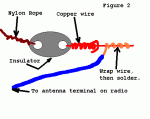Fig. 2 Longwire antenna
I've actually used this kind of antenna. When I was a teenager, I used it with my old Realistic stereo receiver to improve its AM reception, and it did work. (My dad put it up for me.)
Note: RadioShack sells this antenna as a kit, catalog # 278-758, $9.99 in their 2000 Catalog. You might also find it from other electronics suppliers. They sell the antenna wire as catalog # 278-1329, $6.99 in the same catalog. The insulators can be ordered for shipment to your house through RadioShack RSU catalog # 12099248, $4.79 + shipping in the 2000 Catalog.
Find two points, such as two poles (NOT utility poles!), or as most people will do, the corner of your house and a tree. Any safe places above the ground from which you can string this wire will do. Remember that not just the mounting places, but the "air-space" through which the wire will be strung must be free of obstructions, such as trees, and especially power lines. Whatever you do, don't put it on the same corner of the house through which your electrical service enters! First, that will be dangerous, and second, you'll pick up power line noise.
This antenna picks up signals best at right angles. It picks up worst end-on. Therefore, remember to orient the wire to pick up from the direction in which you are most interested.
Using an eye-hook at each point, attach a length of nylon rope. Tie the other end of the nylon rope to each insulator. The bare copper wire is strung from between the insulators, as shown in the diagram.
Use an insulated wire to connect to the copper wire at the end closest to your radio. Strip a couple inches of it and wrap it around the bare copper wire. For best results, solder this connection. This is shown in Figure 2.
If you string the wire from a stationary point (such as a house) to a tree, use this trick that my father taught me, and that Ham Radio operators use. You see, the tree will sway in the breeze, stretching the wire over and over, eventually breaking it. So on the tree, instead of using a plain eye-hook, put up a pully (such as a clothsline pully). Run the nylon rope through this pully, letting a few feet hang down, and tie a brick (or suitable heavy weight) to the end of the rope. This is what I have illustrated in the first diagram. As the tree sways in the breeze, the rope moves feely through the pully, and the weight of the brick keeps the whole thing taut.
Grounding: From the ground terminal on your radio (next to the antenna terminal) run a wire to either a copper cold-water pipe (PVC pipe won't work) or a copper ground rod driven into the ground.
Some safety notes:
1. Keep your antenna far away from power lines! If you, your antenna or your ladder touches a power line, you could be KILLED.
2. Remember that you will be climbing ladders or trees to high place. Observe every safety precaution. Never extend the ladder beyond the manufacturer's reccomendation. Never stretch to reach a point-- instead, move the ladder. Have the ladder on a secure footing, and have someone there to hold the ladder.
3. Make sure your antenna is in a safe place, high enough so people or pets won't walk into it by accident. (Plus, the higher up you get it, the better it works).
4. Use lightening protection! Make provisions to disconnect and ground the antenna when not in use. C. Crane Company and RadioShack offer lightening protection devices. However, disconnecting and grounding the antenna is still the best option. RadioShack sells a simple knife switch you can use for this. Screw it to the wall or table next to the radio, hook one side to the antanna, the other to a wire leading to a copper grounding rod, or the copper cold-water pipe leading outside of your house. (Remember this doesn't work if you forget to throw the switch!)


Hey,
ReplyDeleteVery Informative Blog..!!
Thanks for sharing:)
Regard
Ganpati Engineering